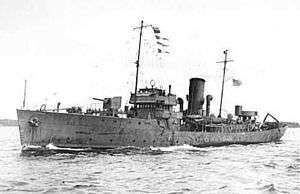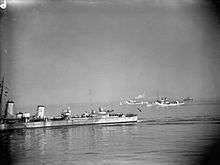HMCS Orillia
 HMCS Orillia | |
| History | |
|---|---|
| Name: | Orillia |
| Namesake: | Orillia, Ontario |
| Ordered: | 1 February 1940 |
| Builder: | Collingwood Shipyards Ltd. Collingwood, Ontario |
| Laid down: | 4 March 1940 |
| Launched: | 15 September 1940 |
| Commissioned: | 25 November 1940 |
| Out of service: | paid off 2 July 1945 |
| Identification: | Pennant number: K119 |
| Honours and awards: | Atlantic 1941–45[1] |
| Fate: | scrapped 1951 |
| General characteristics | |
| Class and type: | Flower-class corvette (original)[2] |
| Displacement: | 925 long tons (940 t; 1,036 short tons) |
| Length: | 205 ft (62.48 m)o/a |
| Beam: | 33 ft (10.06 m) |
| Draught: | 11.5 ft (3.51 m) |
| Propulsion: |
|
| Speed: | 16 knots (29.6 km/h) |
| Range: | 3,500 nautical miles (6,482 km) at 12 knots (22.2 km/h) |
| Complement: | 85 |
| Sensors and processing systems: |
|
| Armament: |
|
HMCS Orillia was a Flower-class corvette that served with the Royal Canadian Navy during the Second World War. She fought primarily in the Battle of the Atlantic. She was named for Orillia, Ontario.
Background
Flower-class corvettes like Orillia serving with the Royal Canadian Navy during the Second World War were different from earlier and more traditional sail-driven corvettes.[3][4][5] The "corvette" designation was created by the French as a class of small warships; the Royal Navy borrowed the term for a period but discontinued its use in 1877.[6] During the hurried preparations for war in the late 1930s, Winston Churchill reactivated the corvette class, needing a name for smaller ships used in an escort capacity, in this case based on a whaling ship design.[7] The generic name "flower" was used to designate the class of these ships, which – in the Royal Navy – were named after flowering plants.[8]
Corvettes commissioned by the Royal Canadian Navy during the Second World War were named after communities for the most part, to better represent the people who took part in building them. This idea was put forth by Admiral Percy W. Nelles. Sponsors were commonly associated with the community for which the ship was named. Royal Navy corvettes were designed as open sea escorts, while Canadian corvettes were developed for coastal auxiliary roles which was exemplified by their minesweeping gear. Eventually the Canadian corvettes would be modified to allow them to perform better on the open seas.[9]
Construction and career
Ordered 1 February 1940 as part of the 1939–1940 Flower-class building program, Orillia was laid down by Collingwood Shipyards on 4 March 1940. Launched 1 September she was commissioned later that year on 25 November at Collingwood, Ontario.[10] She was sent to Halifax to join the convoys.

Orillia was first assigned to Halifax Local Defence Force upon arrival. She served with them until 23 May 1941 when she was assigned as an original member of Newfoundland Escort Force operating out of St. John's, Newfoundland.[11] During this time she was assigned to convoy SC 42, a slow convoy. Orillia was part of an escort group that included the destroyer HMCS Skeena, and corvettes HMCS Alberni and Kenogami. The convoy sailed directly into the path of a U-boat wolfpack of 14 u-boats. During the running battle the Orillia dropped back to pick up survivors and eventually stood by the damaged tanker Tahchee and towed her to Iceland. However the commander, Lieutenant Commander Ted Briggs, RNCR, failed to notify his senior officer that he was doing so for some time, depriving the convoy of one of her few escorts. Though a great humanitarian gesture this added to the mayhem within the convoy. Sixteen ships were sunk during the battle.[12]
On 24 December 1941 she was sent for a refit at Halifax. Upon completion of the refit she joined Escort Group (EG) C-1 and was sent to work up at Tobermory for three weeks. Orillia spent until January 1944 escorting convoys on the Newfy-Derry run. She joined Escort Group C-2 in November 1942 and worked with them until her next refit in March 1944.[11]
Orillia was sent to Liverpool for a lengthy refit, where they lengthened her fo'c'sle. After completing the refit she spent the rest of the war as part of EG W-2.
She was paid off on 2 July 1945 at Sorel. The ship was sold for scrapping in January 1951 and broken up in Hamilton, Ontario.[11][13]
Notes
- ↑ "Battle Honours". Britain's Navy. Retrieved 22 August 2013.
- ↑ Lenton, H.T.; Colledge, J.J (1968). British and Dominion Warships of World War II. Doubleday & Company. pp. 201, 212.
- ↑ Ossian, Robert. "Complete List of Sailing Vessels". The Pirate King. Retrieved 13 April 2011.
- ↑ Fitzsimons, Bernard, ed. (1978). The Illustrated Encyclopedia of 20th Century Weapons & Warfare. 11. London: Phoebus. pp. 1137–1142.
- ↑ Jane's Fighting Ships of World War II. New Jersey: Random House. 1996. p. 68. ISBN 0-517-67963-9.
- ↑ Blake, Nicholas; Lawrence, Richard (2005). The Illustrated Companion to Nelson's Navy. Stackpole Books. pp. 39–63. ISBN 0-8117-3275-4.
- ↑ Chesneau, Roger; Gardiner, Robert (June 1980). Conway's All the World's Fighting Ships (1922–1946). Naval Institute Press. p. 62. ISBN 0-87021-913-8.
- ↑ Milner, Marc (1985). North Atlantic Run. Naval Institute Press. pp. 117–119, 142–145, 158, 175–176, 226, 235, 285–291. ISBN 0-87021-450-0.
- ↑ Macpherson, Ken; Milner, Marc (1993). Corvettes of the Royal Canadian Navy 1939–1945. St. Catharines: Vanwell Publishing. ISBN 1-55125-052-7.
- ↑ "HMCS Orillia (K 119)". Uboat.net. Retrieved 30 July 2013.
- 1 2 3 Macpherson, Ken; Burgess, John (1981). The ships of Canada's naval forces 1910–1981 : a complete pictorial history of Canadian warships. Toronto: Collins. p. 82. ISBN 0-00216-856-1.
- ↑ German, Tony (1990). The Sea is at our Gates : The History of the Canadian Navy. Toronto: McClelland and Stewart Inc. p. 106. ISBN 0-7710-3269-2.
- ↑ "Orillia (6112189)". Miramar Ship Index. Retrieved 14 July 2016. (subscription required (help)).
External links
- Hazegray. "Flower Class". Canadian Navy of Yesterday and Today. Retrieved 30 July 2013.
- Ready, Aye, Ready. "HMCS Orillia". Retrieved 30 July 2013.